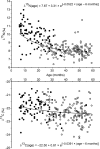Weaning and stunting affect nitrogen and carbon stable isotope natural abundances in the hair of young children
- PMID: 32054911
- PMCID: PMC7018826
- DOI: 10.1038/s41598-020-59402-8
Weaning and stunting affect nitrogen and carbon stable isotope natural abundances in the hair of young children
Abstract
Natural abundances of stable nitrogen and carbon isotopes (δ15N and δ13C) can vary with both dietary intake and metabolic (specifically catabolic) state. In low-income countries, weaning is a period of dietary transition from milk to plant-based foods and a high-risk period for malnutrition. We explored how diet and malnutrition impact hair δ15N and δ13C in young children by an observational, cross-sectional study in Cox's Bazar District, Bangladesh [255 children, 6-59 months with 19.6% wasted (7.1% severely) and 36% stunted (9.8% severely)]. Hair δ15N and δ13C exhibited exponential decreases with age, with the loss of one trophic level (3.3‰ and 0.8‰, respectively) from 6 to 48 months, which we associate with the shift from exclusive breastfeeding to complete weaning. After adjustment for age and breastfeeding status, hair isotopic values were unaffected by wasting but lower in severe stunting (-0.45‰ to -0.6‰, P < 0.01). In this population of young children, whose isotopic values in hair primarily depended on age, we failed to observe any effect of wasting, likely due to opposite, compensating effects between dietary and metabolic changes involved. In contrast, we evidenced low δ15N and δ13C values in severely stunted children that likely indicate chronic exposure to diets low in animal products.
Conflict of interest statement
The authors declare no competing interests.
Figures


Similar articles
-
Detection of breastfeeding and weaning in modern human infants with carbon and nitrogen stable isotope ratios.Am J Phys Anthropol. 2006 Feb;129(2):279-93. doi: 10.1002/ajpa.20249. Am J Phys Anthropol. 2006. PMID: 16261548
-
Effect of a controlled dietary change on carbon and nitrogen stable isotope ratios of human hair.Rapid Commun Mass Spectrom. 2009 Aug 30;23(16):2448-54. doi: 10.1002/rcm.4039. Rapid Commun Mass Spectrom. 2009. PMID: 19603471
-
Stable isotope ratio analysis of breastfeeding and weaning practices of children from medieval Fishergate House York, UK.Am J Phys Anthropol. 2013 Nov;152(3):407-16. doi: 10.1002/ajpa.22370. Epub 2013 Sep 17. Am J Phys Anthropol. 2013. PMID: 24105083
-
Nutrition: basis for healthy children and mothers in Bangladesh.J Health Popul Nutr. 2008 Sep;26(3):325-39. doi: 10.3329/jhpn.v26i3.1899. J Health Popul Nutr. 2008. PMID: 18831228 Free PMC article. Review.
-
Growth Faltering: Underweight and Stunting.Nestle Nutr Inst Workshop Ser. 2020;95:33-40. doi: 10.1159/000511514. Epub 2020 Nov 9. Nestle Nutr Inst Workshop Ser. 2020. PMID: 33166956 Review.
Cited by
-
Comparison of Total Body Vitamin A Stores Using Individual versus Population 13C-Natural Abundance of Serum Retinol in Preschool Children and Women Residing in 6 Diverse African Countries.J Nutr. 2023 Apr;153(4):949-957. doi: 10.1016/j.tjnut.2023.02.002. Epub 2023 Feb 6. J Nutr. 2023. PMID: 36822237 Free PMC article.
-
Stable Isotope Abundance and Fractionation in Human Diseases.Metabolites. 2021 Jun 9;11(6):370. doi: 10.3390/metabo11060370. Metabolites. 2021. PMID: 34207741 Free PMC article. Review.
-
Child-mother relationships and childhood dietary patterns in the Iberian Peninsula uncovered by Bayesian isotopic approaches.Sci Rep. 2025 Apr 13;15(1):12704. doi: 10.1038/s41598-025-97967-4. Sci Rep. 2025. PMID: 40222984 Free PMC article.
-
Reconstructing Hominin Diets with Stable Isotope Analysis of Amino Acids: New Perspectives and Future Directions.Bioscience. 2022 May 23;72(7):618-637. doi: 10.1093/biosci/biac028. eCollection 2022 Jul. Bioscience. 2022. PMID: 35769500 Free PMC article.
-
Commentary: Revisiting Physiological and Theoretical Dimensions of Stable Isotope Variation in Human Tissues.Am J Hum Biol. 2025 Jun;37(6):e70073. doi: 10.1002/ajhb.70073. Am J Hum Biol. 2025. PMID: 40452638 Free PMC article. Review.
References
-
- De Niro MJ, Epstein S. Influence of diet on distribution of carbon isotopes in animals. Geochim. Cosmochim. Acta. 1978;42:495–506. doi: 10.1016/0016-7037(78)90199-0. - DOI
-
- Minagawa M, Wada E. Stepwise enrichment of 15N along food chains: Further evidence and the relation between δ15N and animal age. Geochim. Cosmochim. Acta. 1984;48:1135–1140. doi: 10.1016/0016-7037(84)90204-7. - DOI
-
- Macko Stephen A., Engel Michael H., Andrusevich Vladimir, Lubec Gert, O'Connell Tamsin C., Hedges Robert E. M. Documenting the diet in ancient human populations through stable isotope analysis of hair. Philosophical Transactions of the Royal Society of London. Series B: Biological Sciences. 1999;354(1379):65–76. doi: 10.1098/rstb.1999.0360. - DOI - PMC - PubMed
Publication types
MeSH terms
Substances
LinkOut - more resources
Full Text Sources
Medical

